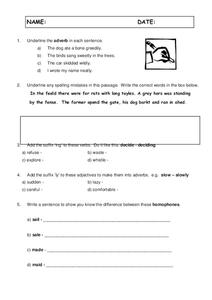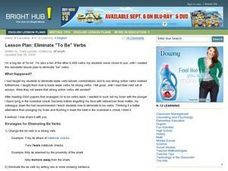K5 Learning
Sharks
"Dun dun... dun dun." A shark! After second graders read a four-paragraph passage about sharks, they respond to four reading comprehension questions that use the text as a basis for the answers.
Curated OER
Reading Comprehension 4: level 9
Whether you use this reading comprehension worksheet as the basis for a short lesson on comprehension strategies or for additional practice, the passage about tricky octopi is sure to engage the interest of your young scientists.
Curated OER
Reading Comprehension 1
What can jump 150 times its own length? Fleas! Assign this reading passage to your class, and they'll not only develop reading skills, but they'll learn about fleas. After reading the excerpt, they answer the questions that follow. All...
Curated OER
Reading comprehension
In this reading comprehension worksheet, 4th graders read passages about Theodor Geisel (Dr. Seuss), sharks, Chinese tales, and more. Students then answer 24 multiple choice questions.
Curated OER
Synonymous Sharks
Students locate and read an Internet article on sharks. They write a summary of the article, and complete a Concept of Definition Map using information from the article.
Curated OER
Fifth Grade Reading
In this 5th grade English/Language Arts standardized test practice worksheet, students read 7 fiction and non-fiction selections and respond to 25 multiple choice questions about the readings.
Curated OER
Reading Comprehension: "CW the Robot"
In this reading comprehension worksheet, learners read a passage titled, "CW The Robot," then complete 12 short answer comprehension questions.
Curated OER
Fiction or Nonfiction
In this recognizing a nonfiction passage, students read a passage about sharks, determine if it is a make-believe fiction passage or a true nonfiction passage, and put an X on their answer choice. Students choose one answer.
Curated OER
Let's Sum It All Up
Fourth graders watch a modeled lesson plan on summarizing the main ideas of a non-fiction passage. They silently read a passage about sharks before making a class summarization chart. Next, they read a small passage and summarize it...
Curated OER
Fragments
In this sentence correction worksheet, students read the passage about a mermaid. Students then locate and fix the fragments within the passage.
Curated OER
Yao Ming
In this famous person worksheet, students read a passage about Yao Ming and then complete a variety of in-class and homework activities to support comprehension, including partner interviews, spelling, cloze, synonym matches, and...
Curated OER
Steven Spielberg
In this famous person worksheet, students read a passage about Steven Spielberg and then complete a variety of in-class and homework activities to support comprehension, including partner interviews, spelling, cloze, synonym matches, and...
Curated OER
Misplaced and Dangling Modifiers - Exercise 2
Getting tired of seeing dangling or misplaced modifiers in your students' writing? Use this grammar activity to reinforce the importance of careful reading and editing. Young writers find the sentence that has no misplaced or dangling...
Curated OER
Spelling Plurals
In this spelling plurals worksheet, students study the 5 common rules for spelling plurals. Students fill in a chart in which the singular nouns are made plural. Then students find plurals in their reading books and classify them...
Curated OER
Eliminate "To Be" Verbs
Students remove to beverbs from their writing. For this verb usage lesson, students write strategies from eliminating to be verbs, then locate the verbs in their writing and eliminate as many as possible.
















